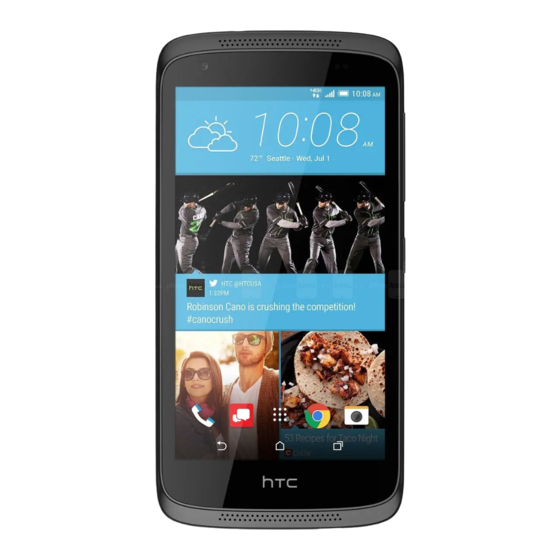HTC DESIRE 526 Service-Handbuch - Seite 22
Blättern Sie online oder laden Sie pdf Service-Handbuch für Mobiltelefon HTC DESIRE 526 herunter. HTC DESIRE 526 48 Seiten.
Auch für HTC DESIRE 526: Kennenlernen (2 seiten)

indicates that using a wireless phone while driving degrades
a driver's performance, whether it is a hands-free or hand-
held wireless phone. NHTSA advises that the "safest course
of action is to refrain from using a cell phone while driving."
NHTSA's policy on "Cell Phone Use While Driving," as well as
Frequently Asked Questions on the subject, are available at
www.nhtsa.gov (click on "Traffic Safety" then on "Drowsy and
Distracted Driving").
For your well-being and the well-being of those around you, you
should consider turning your phone off and allowing calls to go
to voice mail while you are driving.
If you choose to use your wireless phone while driving, several
jurisdictions have adopted "hands-free" and other restrictions
on the use of wireless devices while driving. It is your
responsibility to know and to comply with the law in your area.
Caution: Avoid Potential Hearing Loss
Prolonged exposure to loud sounds (including music) is the most
common cause of preventable hearing loss. Some scientific
research suggests that using portable audio devices, such as
portable music players and cellular telephones, at high volume
settings for long durations may lead to permanent noise-
induced hearing loss. This includes the use of headphones
(including headsets, earbuds and Bluetooth® or other
wireless devices). Exposure to very loud sound has also been
associated in some studies with tinnitus (a ringing in the ear),
hypersensitivity to sound and distorted hearing. Individual
susceptibility to noise-induced hearing loss and other potential
hearing problems varies.
41
The amount of sound produced by a portable audio device
varies depending on the nature of the sound, the device, the
device settings and the headphones. You should follow some
commonsense recommendations when using any portable
audio device:
• Set the volume in a quiet environment and select the lowest
volume at which you can hear adequately.
• When using headphones, turn the volume down if you
cannot hear the people speaking near you or if the person
sitting next to you can hear what you are listening to.
• Do not turn the volume up to block out noisy surroundings.
If you choose to listen to your portable device in a noisy
environment, use noise-cancelling headphones to block out
back ground environmental noise.
• Limit the amount of time you listen. As the volume
increases, less time is required before your hearing could
be affected.
• Avoid using headphones after exposure to extremely loud
noises, such as rock concerts, that might cause temporary
hearing loss. Temporary hearing loss might cause unsafe
volumes to sound normal.
• Do not listen at any volume that causes you discomfort. If
you experience ringing in your ears, hear muffled speech or
experience any temporary hearing difficulty after listening
to your portable audio device, discontinue use and consult
your doctor.
42
